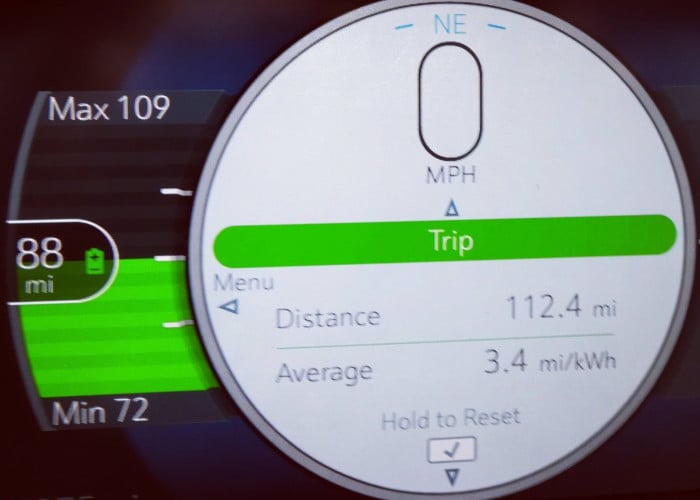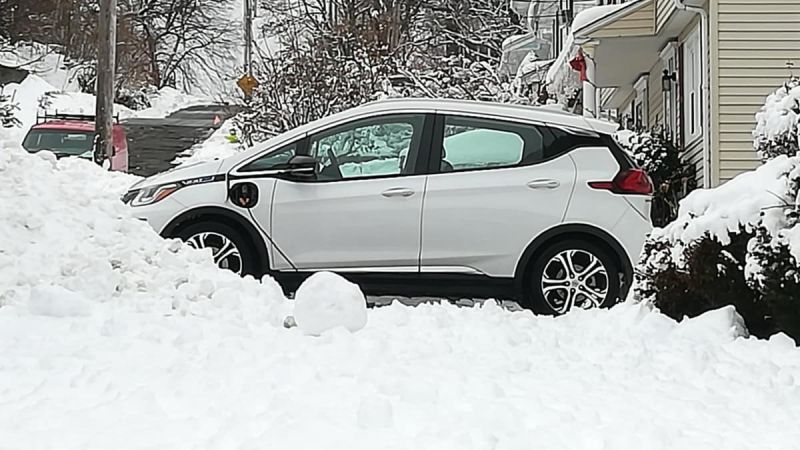Cold weather performance is an important topic for EV drivers and those considering the transition to electric vehicles. We know that winter inhibits performance, but that's also true of combustion engine vehicles and the claims about electric cars are often overblown, perhaps with an underlying desire to discredit electrification altogether.
As I covered earlier this year, manufacturers including GM and Hyundai are prioritizing winter performance in their updates for the 2020 model year. Tesla has also delivered OTA updates to improve cold weather performance, but what can those of us who don't see such frequent software enhancements do to help our EVs through a deep freeze?
On a recent weekend city break to Portland, ME, my wife and I documented two similar drives in our Bolt EV that showed us just how much a small adjustment can make to winter efficiency.

Mass. to Maine in a Chevy Bolt EV
The route itself isn't at all challenging for our 2017 Chevy Bolt EV, even with its lower range than the updated 2020 Bolt EV and freezing temperatures weighing on our efficiency.
In normal conditions, the round trip from Boston, MA to Portland, ME is around 220 miles and sits within the car's 238 miles of EPA estimated range, though a destination charge while enjoying the city is required for comfort on the return leg.
Nonetheless, the cold weather and high Interstate speeds of this trip made for an interesting comparison of the outbound and return trips, both of which covered around 112 miles in similar conditions, yet yielded very different results in terms of efficiency.
Let's take a look at the numbers:
Boston, MA to Portland, ME:
Distance - 111.8 miles
Efficiency - 2.9 miles per kWh (would = 174 miles on a full charge)
Drive Time - 1 hour 56 minutes
Temperature - 31-33°F
Portland, ME to Boston, MA:
Distance - 112.4 miles
Efficiency - 3.4 miles per kWh (would = 204 miles on a full charge)
Drive Time - 2 hours 9 minutes
Temperature - 32-35°F

I have to disclose a slight deviation in conditions over the final 15 miles of our return trip, as light snow and traffic combined to slow our progress and improve efficiency beyond the headline calculations of this article.
However, as the video below shows, we achieved 3.3 miles per kWh over the first 90 miles in similar dry, cold conditions and would expect that level to hold at sustained highway speeds with no change in weather. This is where the 0.4 mi/kWh improvement comes from and how I calculated the increase of almost 14% range for the return leg.
Watch a summary of the trip to Portland, ME - and our efficiency along the way - in the video below.
Where Did Our 13.8% Increase in Return Range Come From?
To cut a long story short, we changed drivers. To make it slightly longer (and admit culpability), my wife is more efficient in her use of electrons!
I drove the outbound leg, eager to arrive and start exploring the city of Portland, ME. We pushed the higher end of rapid travel along I-95 North, only keeping up with the quicker vehicles but, nonetheless, hitting speeds that the Bolt EV's shape doesn't enjoy as much as more aerodynamic sedans like the Tesla Model 3 or Hyundai Ioniq. I knew we had ample charging options at the destination and even en route if needed, so I didn't focus on efficiency.
By contrast, my better half took the wheel for the return leg and took a more sedate approach, lingering around the speed limit and allowing more lead-footed New Englanders to whip by on our left.
The results speak for themselves, with a simple reduction of 5 to 7 mph on the way home yielding that 14% improvement in efficiency and only a minor increase in drive time. In truth, without the traffic delays in those final miles, there's a good chance that the time difference would only have amounted to a few minutes.
Unfortunately, we didn't record average speeds along either route, but the traffic was generally free-flowing for the trip and we observed our efficiency slowly ticking up as the miles passed on the way home. There are no significant elevation changes along this coastal route and winds were minimal on both occasions.
That short and slushy final portion of our return drive notwithstanding, a more sedate pace was the only significant difference between the outbound and return journeys.
A Takeaway for Electric Vehicle Drivers in Winter
Last month, I offered several other tips to prepare your EV for winter. In this case, there's only one clear factor in our improved range: speed.
I'm aware this doesn't come as news to experienced EV drivers, but it's my hope that new electric vehicle owners preparing for a cold-weather road trip will be able to factor our results to make their journeys more comfortable.
If you're heading out on a long trip for the holidays and want to make the most of your range to offset any winter losses, ease off the go pedal and enjoy the scenery.
Have you seen significant improvements in efficiency by knocking a few miles per hour off your high-speed driving? What kind of range are you getting from your EV as the winter months arrive? Let us know in the comments.
Steve Birkett is an electric vehicle advocate at Plug & Play EV. You can follow him on Twitter at @plugandplayEV, Instagram and YouTube at Plug & Play EV channel to send him EV news tips.













Comments
Thanks for the informative
Permalink
Thanks for the informative video, especially the tips about free charging in my hometown of Portland. Just FYI: according to the Electrify America app, the charging stations at the Walmart in Scarborough Maine are now online.